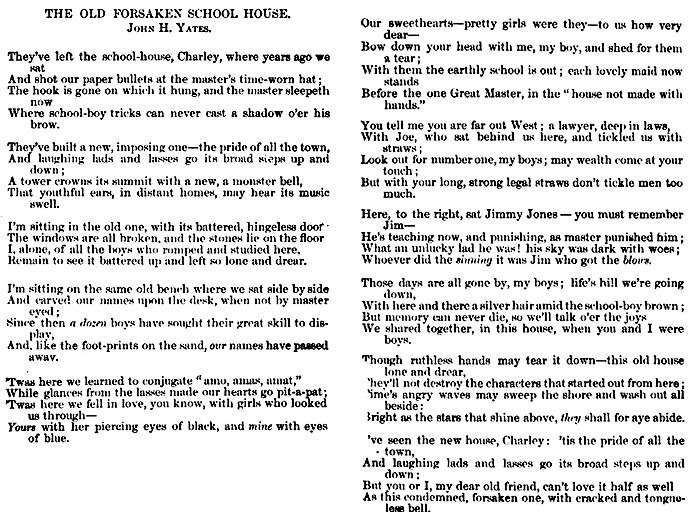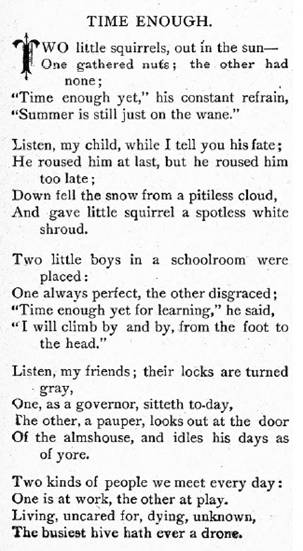Music and Moralizing
With the conclusion of the speeches, one might think that everything that had to be said up front had been said, and that a formal tour of the new building could begin. That was not the case, however - after all, even Super Bowl fans seem to think that a half-time show is necessary.
In this instance, the "half-time show" consisted primarily of 15 carefully rehearsed student recitations, each complete with declamatory gestures and exaggerated facial expressions, of well-worn writings that were didactic, and often joyless. Allowing on average six minutes for each speaker to rise, walk forward, declaim, accept applause, and return to a seat, we can assume that the recitations in total took at least 90 minutes to complete.
The Brooklyn Daily Eagle, January 3, 1898
The declamations were punctuated by musical performances. The first of the latter was a piano rendition of Marching Through Georgia, which would have stirred the audience, amongst whom were a number of Civil War veterans (none of whom, one hopes, had worn gray and fought for Georgia). There was a solo of The Star-Spangled Banner, sung by Jennie Hahn, 10, daughter of merchant John Hahn. Also on the program were another piece (unnamed) on the piano, and two numbers played by the band. The first of the latter was Red, White and Blue; so many pieces of music have used these words as a title or subtitle that one cannot be certain which of them was played. The second was Listen to the Mockingbird (if I am not mistaken, in the 1960s television series The Prisoner, this was one of the recurring pieces of "uplifting" music played in The Village). Note that the pianist for this part of the dedication, Blanca Kreuscher, was not local; she was part of a well-known German family that owned a hotel in the Rockaways.
Fortunately for the reader, I have not located the texts of every item that was declaimed, and thus I can inflict only a few more examples on you. The first was performed by Adam Lauck, 14, whose mother was a cutter of silver leaf. He had the misfortune of presenting this long and over-sentimental item:

The Speaker's Garland, edited by Phineas Garrett
Volume II, 1892
Andrew Heberer, 10 years old, and son of the storekeeper of the same name, got to read this version of the old grasshopper-ant theme:

Delightful Stories of Travel at Home and Abroad etc.,
edited by Allen E. Fowler, 1895
Part VI Elocution Exercises
You may have noted that the above rather cautionary tale was included in an anthology of supposedly "delightful" stories. Similarly, J. Ofenloch (who was either John or Joseph, both about 11 years old and sons of blacksmith Philip) got to read The Contrary Boy, a painfully long tale of a spoiled little fellow, printed in an anthology from 1853, which somehow was called The Favorite Story Book, or Pleasing Sketches for Youth. I am profoundly grateful that when I was 11, I was not forced to read such a thing - I would have been compelled (and ready) to argue with my teacher that the following excerpt, and in fact the entirety of the piece, has no place in any collection of "pleasing sketches."

One of the more upbeat portions of "The Contrary Boy"
The Favorite Story Book, or Pleasing Sketches for Youth
edited by Clara Arnold, 1853
***

